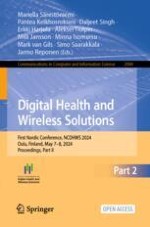1 Introduction
2 Methods
2.1 Participants and Study Design
2.2 Digital Health Intervention App (BitHabit)
2.3 Study Variables
Category | Question(s) | Answer options |
|---|---|---|
Use of e-services | Do you use the Internet to access e-services (e.g. My Kanta, MyTax, OmaKela)? | 1) I use it independently, 2) I use it with another person’s help or someone else uses it on my behalf, 3) I don’t use it |
Competence to use e-services | How would you rate your competence to use online services (on a computer or smartphone)? | 1) No competence or low competence, 2) Moderate competence, 3) High or very high competence |
Non-accessibility of e-services | How do you feel about the following statement: the electronic services are not accessible to me e.g. due to my visual impairment | 1) Completely agree or somewhat agree, 2) Neither agree nor disagree, 3) Somewhat disagree or strongly disagree |
Data security | How do you feel about the following statement: I am concerned about data security when it comes to my personal details | 1) Completely agree, 2) Somewhat agree, 3) Neither agree nor disagree, 4) Somewhat disagree, 5) Strongly disagree |
Data connections | How do you feel about the following statement: data connections are poor in my area | 1) Completely agree or somewhat agree, 2) Neither agree nor disagree, 3) Somewhat disagree or strongly disagree |
Benefits of digital services | Electronic services… 1) Help me to assess the need for services, 2) Support me in finding and choosing the most suitable services, 3) Make it easier for me to use services regardless of where I am and when, 4) Make it easier for me to collaborate with professionals 5) Help me to take an active role in looking after my own health and welfare, 6) Help me to take care of the health, welfare and functional capacity of family or friends | 1) Completely agree, 2) Somewhat agree, 3) Neither agree nor disagree, 4) Somewhat disagree, 5) Strongly disagree |
2.4 Statistical Methods
3 Results
All | Started using DHI | Did not start using the DHI | |
|---|---|---|---|
Sex | |||
Female | 3975 (57%) | 868 (67%) | 3107 (55%) |
Male | 3000 (43%) | 419 (33%) | 2581 (45%) |
Age (years) | |||
20 – 34 | 1229 (18%) | 250 (19%) | 979 (17%) |
35 – 49 | 1254 (18%) | 303 (24%) | 951 (17%) |
50 – 64 | 2066 (30%) | 361 (28%) | 1705 (30%) |
65 – 74 | 2426 (35%) | 373 (29%) | 2053 (36%) |
Lifestyle score | |||
Low | 1150 (19%) | 172 (15%) | 978 (20%) |
Middle | 2350 (39%) | 422 (36%) | 1928 (39%) |
High | 2588 (43%) | 576 (49%) | 2013 (41%) |
Education | |||
Low | 1791 (26%) | 206 (16%) | 1585 (28%) |
Middle | 3036 (44%) | 549 (43%) | 2487 (44%) |
High | 2053 (30%) | 522 (41%) | 1531 (27%) |
